
Black is a color which results from the absence or complete absorption of visible light. It is an achromatic color, without hue, like white and grey. It is often used symbolically or figuratively to represent darkness. Black and white have often been used to describe opposites such as good and evil, the Dark Ages versus Age of Enlightenment, and night versus day. Since the Middle Ages, black has been the symbolic color of solemnity and authority, and for this reason it is still commonly worn by judges and magistrates.

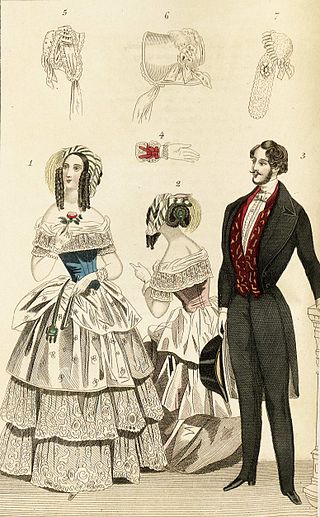
Victorian fashion consists of the various fashions and trends in British culture that emerged and developed in the United Kingdom and the British Empire throughout the Victorian era, roughly from the 1830s through the 1890s. The period saw many changes in fashion, including changes in styles, fashion technology and the methods of distribution. Various movement in architecture, literature, and the decorative and visual arts as well as a changing perception of gender roles also influenced fashion.

Mourning is the expression of an experience that is the consequence of an event in life involving loss, causing grief, occurring as a result of someone's death, specifically someone who was loved although loss from death is not exclusively the cause of all experience of grief.

A wedding dress or bridal gown is the dress worn by the bride during a wedding ceremony. The color, style and ceremonial importance of the gown can depend on the religion and culture of the wedding participants. In Western cultures and Anglo-Saxon cultural spheres, the wedding dress is most commonly white, a fashion made popular by Queen Victoria when she married in 1840. In Eastern cultures, brides often choose red to symbolize auspiciousness.

The hanbok is a traditional clothing of the Korean people. The term hanbok is primarily used by South Koreans; North Koreans refer to the clothes as chosŏn-ot (조선옷). The clothes are also worn in the Korean diaspora, especially by Koreans in China.
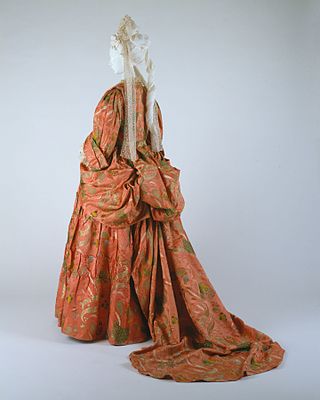
A mantua is an article of women's clothing worn in the late 17th century and 18th century. Initially a loose gown, the later mantua was an overgown or robe typically worn over stays, stomacher and either a co-ordinating or contrasting petticoat.

Serbian traditional clothing, also called as Serbian national costume or Serbian dress, refers to the traditional clothing worn by Serbs living in Serbia, Croatia, Bosnia and Herzegovina, Montenegro, and the extended Serbian diaspora communities in Austria, Australia, Bulgaria, Canada, France, Germany, Greece, Hungary, North Macedonia, Romania, Russia, Slovenia, United States, etc. Like any traditional dress of a nation or culture, it has been lost to the advent of urbanization, industrialization, and the growing market of international clothing trends. The wide range of regional folk costumes show influence from historical Austrian, Hungarian, German, Italian, and Ottoman Turkish presence. Nonetheless, the costumes are still a pinnacle part of Serbian folk culture. From the 19th century and onwards, Serbs have adopted western-styled clothing. This change has started in larger settlements such as cities and towns, although it was not uncommon to see rural women in traditional working costumes all the way until the end of President Josip Broz Tito's term. Today, these national costumes are only worn by some elderly in rural areas but are most often worn with connection to special events and celebrations, mostly at ethnic festivals, religious and national holidays, weddings, tourist attractions, and by dancing groups who dance the traditional Serbian kolo, or circle dance.
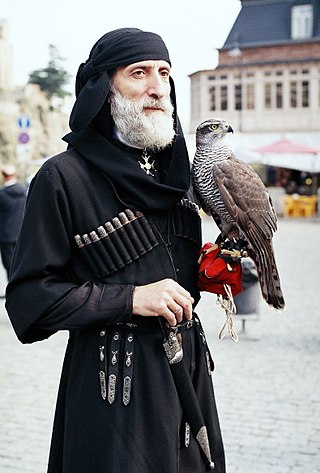
A chokha also known as a cherkeska is a woolen coat with a high neck that is part of the traditional male dress of peoples of the Caucasus. It was in wide use among Avars, Abazins, Abkhazians, Eastern Armenians, Azerbaijanis, Balkars, Chechens, Circassians, Georgians, Ingush, Karachays, Nogais, Ossetians, Tats, the peoples of Dagestan, as well as Terek and Kuban Cossacks who adopted it from the aforementioned peoples.
Thomas Patrick Campbell is the director and CEO of the Fine Arts Museums of San Francisco, overseeing the de Young and Legion of Honor museums. He served as the director and CEO of the Metropolitan Museum of Art between 2009 and 2017. On 30 June 2017, Campbell stepped down as director and CEO of the Metropolitan Museum of Art under pressure and accepted the Getty Foundation's Rothschild Fellowship for research and study at both the J. Paul Getty Museum in Los Angeles and at Waddesdon Manor, in the UK.

Gwanbok is a Korean term which was borrowed from the Chinese terms guanfu and guanfu. The term gwanbok is a collective term which refers to historical official attire, which was bestowed by the government court, including Chinese courts of various dynasties. The guanfu (冠服) system was a court attire system in China which also formed part of the Hanfu system. This system was them spread to neighbouring countries and was adopted in Korea since ancient times in different periods through the ritual practice of bestowal of clothing. Acknowledgement through bestowed robes and crowns (冠服) from the Emperor of China, who held hegemony over East Asia, would give support to Korean Kings and successors, as being the authentic rulers of their country as well as confirmed the political status of the Korean kingdom in the rest of the Sinosphere. The gwanbok system in Korea was different for each kingdom and changed throughout different periods. For example, initially given by the Chinese court in ritual practice, successive gwanbok were more often than not locally manufactured in Korea with different colours and adopted into hanbok. The gwanbok, which was used as the uniform of court officials, formed part of the gwanbok system and was used like the suit is nowadays.

Self Portrait is an oil-on-canvas painting by the Dutch artist Rembrandt. Painted in 1652, it is one of more than 40 painted self-portraits by Rembrandt, and was the first he had painted since 1645. In composition it is different from his previous self-portraits, depicting the painter in a direct frontal pose, hands on his hips, and with an air of self-confidence. It was painted the year that his financial difficulties began, and breaks with the sumptuous finery he had worn in previous self-portraits. Art historian Christopher White has called it "one of the most magisterial and sombre of these (late) pictures". It is in the Kunsthistorisches Museum in Vienna.
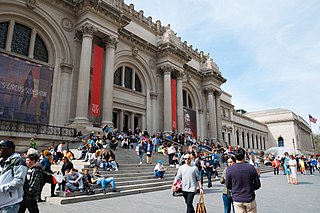
The Met Gala or Met Ball, formally called the Costume Institute Gala or the Costume Institute Benefit, is an annual fundraising gala held for the benefit of the Metropolitan Museum of Art's Costume Institute in New York City. The Met Gala is popularly regarded as the world's most prestigious and glamorous fashion event and social gathering and is known as "fashion's biggest night"; an invitation is highly sought after. Personalities who are perceived to be culturally relevant to contemporary society amongst various professional spheres, including fashion, film, television, music, theater, business, sports, social media, and politics, are invited to attend the Met Gala, organized by the fashion magazine Vogue.

Traditional clothing is one of the factors that has differentiated this nation from neighboring countries, dating back as far as the Illyrian era.

Greek dress refers to the clothing of the Greek people and citizens of Greece from the antiquity to the modern times.
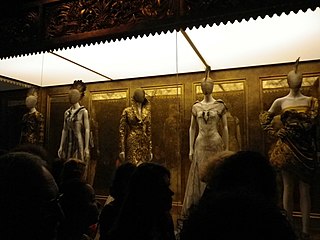
The Anna Wintour Costume Center is a wing of the Metropolitan Museum of Art's main building in Manhattan that houses the collection of the Costume Institute, a branch of the museum focused on fashion and costume design. The center is named after Anna Wintour, the longtime and current editor-in-chief of Vogue, Chief Content Officer of Condé Nast, and chair of the museum's annual Met Gala since 1995. It was endowed by Lizzie and Jonathan Tisch. As of August 2017, the chief curator is Andrew Bolton.
Andrew John Bolton is a British museum curator and current head curator of the Anna Wintour Costume Center at the Metropolitan Museum of Art in New York City.
Jacqueline Kennedy: The White House Years was a 2001 exhibition that was presented by the Costume Institute at the Metropolitan Museum of Art. The event was timed to mark the 40th anniversary of her "emergence as America’s first lady." Organized by The Metropolitan Museum of Art and the John F. Kennedy Library and Museum, the exhibition was devoted to exploring the former First Lady's iconic style and impact on the fashion world.
American Woman: Fashioning a National Identity was an exhibit at the Metropolitan Museum of Art in New York City, New York that ran from May 5 to August 15, 2010. This exhibition explored the evolution of the modern woman's image from the 1890s to the 1940s in the United States. Taking approximately nine months to complete, the goal of the exhibition was to create a "time machine" of women's clothing from the past to present. The exhibit was the first from the Costume Institute to incorporate pieces from the Brooklyn Museum Costume collection which had recently been transferred to the Met's holdings. The exhibition, consisting of a range of women's clothing from ball gowns to cycling suits, displayed the impact of "Gibson Girls", "Screen Sirens", and "Bohemians" on American women.
Heavenly Bodies: Fashion and the Catholic Imagination was the 2018 high fashion art exhibition of the Anna Wintour Costume Center, a wing of the Metropolitan Museum of Art (MMA) which houses the collection of the Costume Institute.















